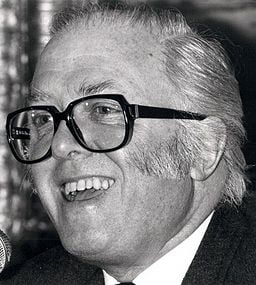
Early Life
Sir Alec Guinness was born Alec Guinness de Cuffe on 2 April 1914 in Maida Vale, Westminister, London. He was the son of Agnes de Cuffe but his father’s name was never recorded on his birth certificate. However, Guinness himself, among others, believed that his father was the wealthy banker Andrew Geddes. This was largely based on the fact that Geddes paid for his private boarding-school education at Pembroke Lodge in Eastbourne. It was during his schooldays that Guinness first began to show a great interest in acting.
Aged 18, Guinness took a job in advertising but soon left to study acting. In 1934, he made his stage debut as an extra at the King’s Theatre in Hammersmith. In 1936, Guinness got his first proper acting job at the New Theatre, joining John Gielgud’s production of Hamlet. Later that year he joined the Old Vic, where he would later appear in Shakespearian plays and other classic productions.
Early Film Career
In 1941, during WW2, Guinness joined the Royal Naval Reserve as a seaman. He later received a commission and ended up captaining a landing craft at the Allied invasion of Sicily. In 1946, Guinness returned to London’s West End, once again taking up numerous roles in classic theatre. Also in 1946, he took up his first film role in a screen adaption of Charles Dickens’s Great Expectations.
In the late 1940s, Guinness joined the Ealing Comedies film production team. He was particularly lauded for playing nine different characters in Kind Hearts and Coronets (1949). He then went on to take a leading role in The Lavender Hill Mob (1951), The Man in the White Suit (1951), and The Ladykillers (1955). One of Guinness’s most memorable screen performances came in the Anglo-American production of The Bridge on the River Kwai (1957). Set in a Japanese POW camp in Burma during WWII, Guinness’s portrayal of Colonel Nicholson earned him the 1958 best-actor Oscar. He went on to gain further critical acclaim for his co-starring roles in The Horse’s Mouth (1958), Lawrence of Arabia (1962), and Doctor Zhivago (1965).

Alec Guinness as Sidney Stratton in The Man in the White Suit (1951). Photo credit: Flickr/PDM 1.0
Stars Wars and After
Guinness won over a new generation of film fans when he starred as the Jedi warrior Ben (Obi-Wan) Kenobi in Star Wars (1977), The Empire Strikes Back (1980), and Return of the Jedi (1983). The role brought him newfound popularity and unimaginable wealth, since with great foresight he negotiated a royalties contract. Nonetheless, Guinness hated the Kenobi role and persuaded director George Lucas to kill off the character. He stated shortly after achieving his aim ”I’d had enough of the mumbo jumbo.”
The multi-talented Guinness also starred as the double agent George Smiley, to much acclaim, in the TV adaption of John Le Carre’s Tinker, Tailor, Soldier, Spy (1980) and Smiley’s People (1982). He won two BAFTA’s for Best Actor for his portrayal of the character. Other notable roles in the 1980s for Guinness were that of Professor Godbole in A Passage to India (1984) and William Dorrit in Little Dorrit (1987). Guinness’s last screen appearance was for the BBC in the comedy-drama Eskimo Day in 1996.
Throughout his long career, Guinness appeared in more than 50 films. Nine of those films featured in the British Film Institute’s 100 greatest British films of the 20th century with Guinness featuring more than any other actor. All through his working life, Guinness also managed to maintain a theatre career. In all, between 1934 and 1989, he appeared in 77 major stage productions. He made his final stage performance in London’s West End on 30 May 1989, in the play A Walk in the Woods.
Private Life, Honours, and Death
In 1938, Guinness married the artist, playwright, and actress Merula Silvia Salaman (1914–2000). Their only offspring, Matthew Guinness, was born in 1940. He would later became an actor.
In 1959, Guinness received a knighthood from Elizabeth II for his services to the arts. A year later he received a star on the Hollywood Walk of Fame. In 1980, Guinness was presented with an honourary Academy Award for lifetime achievement in the film industry. And, in 1989, he was awarded a BAFTA Academy Fellowship.
In 1986, Guinness published his autobiography, Blessings in Disguise. He later released two volumes from his personal diaries; My Name Escapes Me: The Diary of a Retiring Actor (1997), and A Positively Final Appearance (1999).
Diagnosed with terminal cancer, Guinness died on the night of 5 August 2000 at King Edward VII’s Hospital, Midhurst. His wife Silvia also died of cancer just 2 months later. They are interred side by side at Petersfield Cemetery in Hampshire.
Header image credit: David Fowler/Shutterstock.com





